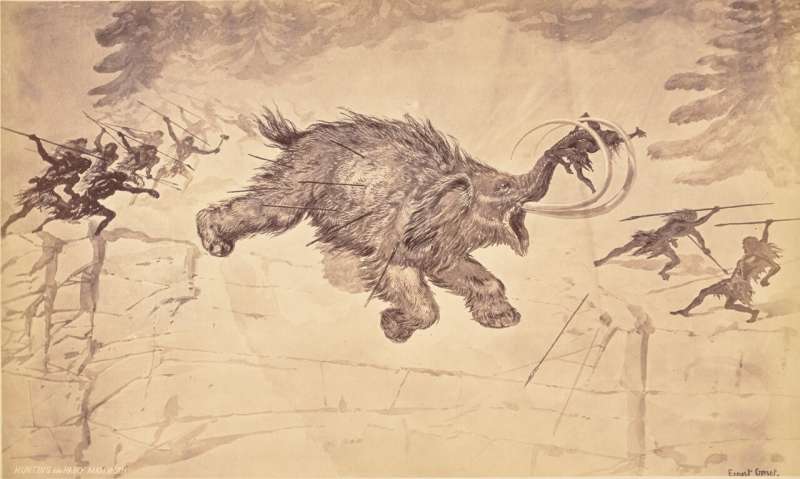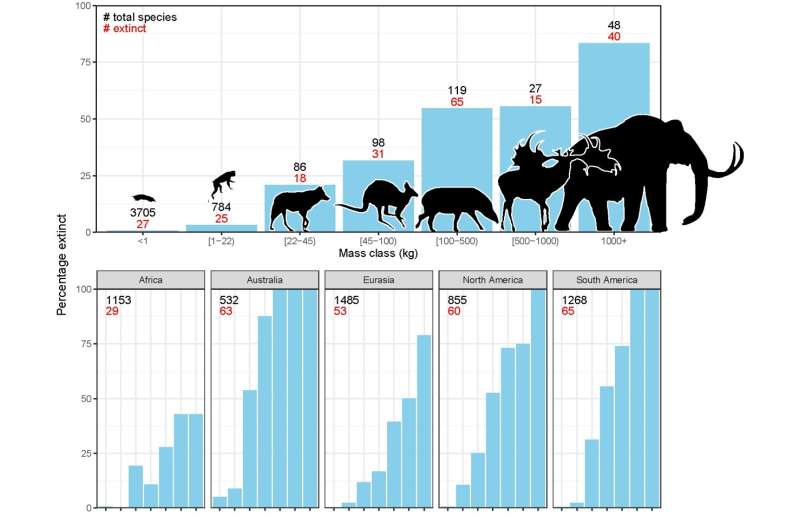
Prehistoric humans hunted a woolly mammoth. A growing body of research shows that this species, along with at least 46 other species of megaherbivores, was driven to extinction by humans. Credit: Engraving by Ernest Grise, photographed by William Henry Jackson. Getty Open Content Program
The debate has raged for decades: was it humans or climate change that led to the extinction of many species of large mammals, birds and reptiles that have disappeared from Earth over the past 50,000 years?
By “large” we mean animals that weighed at least 45 kilograms, called megafauna. At least 161 species of mammals became extinct during this period. This figure is based on remains found so far.
The largest of these have been the most affected: megaherbivores, terrestrial herbivores weighing more than a ton. Fifty thousand years ago, there were 57 species of megaherbivores. Today, there are only 11 left. These 11 remaining species have also experienced drastic population declines, but not to the point of disappearing completely.
A research group from the Centre for Ecological Dynamics in a New Biosphere (ECONOVO) of the Danish National Research Foundation at Aarhus University now concludes that many of these extinct species were hunted to extinction by humans.
They present this conclusion in an invited review article published in the journal Cambridge Prisms: ExtinctionA review article synthesizes and analyzes existing research in a particular field.
In this case, researchers from Aarhus University integrated several research areas, including studies directly related to the extinction of large animals, such as:
- The calendar of species extinctions
- Animal Food Preferences
- Climate and habitat requirements
- Genetic estimates of past population sizes
- Evidence of human hunting
In addition, they included a wide range of studies from other fields necessary for understanding the phenomenon, such as:
- Climate history over the last 1 to 3 million years
- History of vegetation over the last 1 to 3 million years
- Evolution and dynamics of fauna over the last 66 million years
- Archaeological data on human expansion and lifestyle, including dietary preferences

This figure shows how the extinction of large mammals during the end of the Quaternary is related to their body size. At the top, you can see the global percentage of species that went extinct based on their body size. The bottom part breaks it down by continent. The black numbers represent the total number of species that lived during this period, including those that still exist and those that went extinct. The red numbers indicate species that went extinct. Credit: Aarhus University ECONOVO / Cambridge Prisms: Extinction
Climate change played a lesser role
The dramatic climate changes that occurred during the last interglacial and glacial periods (known as the Late Pleistocene, from 130,000 to 11,000 years ago) certainly affected the populations and distribution of animals and plants, large and small, around the world. However, significant extinctions were observed only among large animals, particularly the largest ones.
It is important to note that previous, equally dramatic glacial and interglacial periods over the past few million years did not result in selective loss of megafauna. Particularly at the beginning of the glacial periods, the new cold and dry conditions caused large-scale extinctions in some regions, such as trees in Europe. In contrast, there were no selective extinctions of large animals.
“The massive and highly selective extinction of megafauna over the past 50,000 years is unique in the past 66 million years. Previous periods of climate change have not led to massive and selective extinctions, which argues against a major role of climate in megafauna extinctions,” says Professor Jens-Christian Svenning. He leads ECONOVO and is the lead author of the paper.
He adds: “Another significant pattern that argues against the role of climate is that recent megafauna extinctions have hit climatically stable areas as hard as unstable areas.”
Effective hunters and vulnerable giants
Archaeologists have discovered traps designed for very large animals, and isotopic analyses of ancient human bones and protein residue from spear points show that they hunted and ate larger mammals.
Svenning adds: “Early modern humans were effective hunters, even of the largest animal species, and clearly had the ability to reduce populations of large animals. These large animals were and are particularly vulnerable to overexploitation because they have long gestation periods, produce very few offspring at a time, and take many years to reach sexual maturity.”
The analysis shows that human hunting of large animals such as mammoths, mastodons and giant sloths was widespread and constant throughout the world.
The study also shows that species went extinct at very different times and rates in different parts of the world. In some regions, extinction happened quite quickly, while in others it took more than 10,000 years. But everywhere it happened after the arrival of modern humans or, in the case of Africa, after human cultural advances.
Species have disappeared on every continent except Antarctica and in every type of ecosystem, from tropical forests and savannas to Mediterranean and temperate forests and steppes to Arctic ecosystems.
“Many extinct species could thrive in different types of environments. Therefore, their extinction cannot be explained by climate change causing the disappearance of a specific type of ecosystem, such as the mammoth steppe, which also supported only a few species of megafauna,” Svenning says.
“Most species lived in temperate to tropical conditions and should have benefited from the warming at the end of the last ice age.”
Consequences and recommendations
The researchers point out that the disappearance of megafauna has had profound ecological consequences. Large animals play a central role in ecosystems by influencing vegetation structure (e.g., the balance between dense forests and open areas), seed dispersal, and nutrient cycling. Their disappearance has led to significant changes in ecosystem structures and functions.
“Our results highlight the need for active conservation and restoration efforts. By reintroducing large mammals, we can help restore ecological balances and support biodiversity, which has evolved in megafauna-rich ecosystems,” says Svenning.
More information:
Jens-Christian Svenning et al., Late Quaternary megafaunal extinctions: patterns, causes, ecological consequences, and implications for ecosystem management in the Anthropocene era, Cambridge Prisms: Extinction (2024). DOI: 10.1017/ext.2024.4
The figures for extinct and surviving species come from the open-access database PHYLACINE 1.2.1, which lists all known mammals that lived in the last 129,000 years, including those that have recently become extinct or are only found in captivity.
Provided by Aarhus University
Quote:Evidence Mounting: Humans Responsible for Extinction of Large Mammals (2024, July 1) retrieved July 1, 2024 from https://phys.org/news/2024-07-evidence-mounting-humans-responsible-extinction.html
This document is subject to copyright. Apart from any fair dealing for the purpose of private study or research, no part may be reproduced without written permission. The content is provided for informational purposes only.